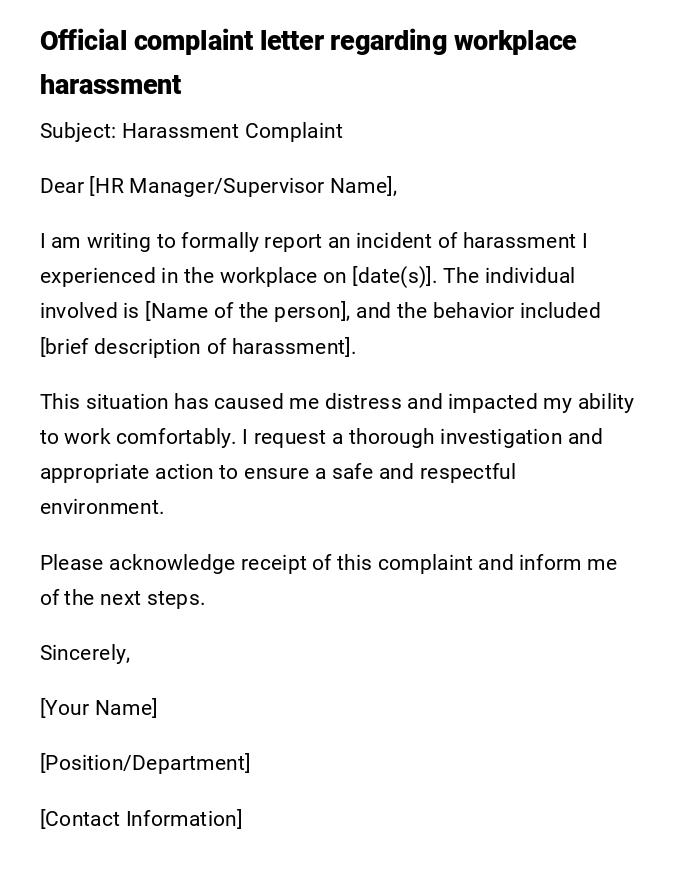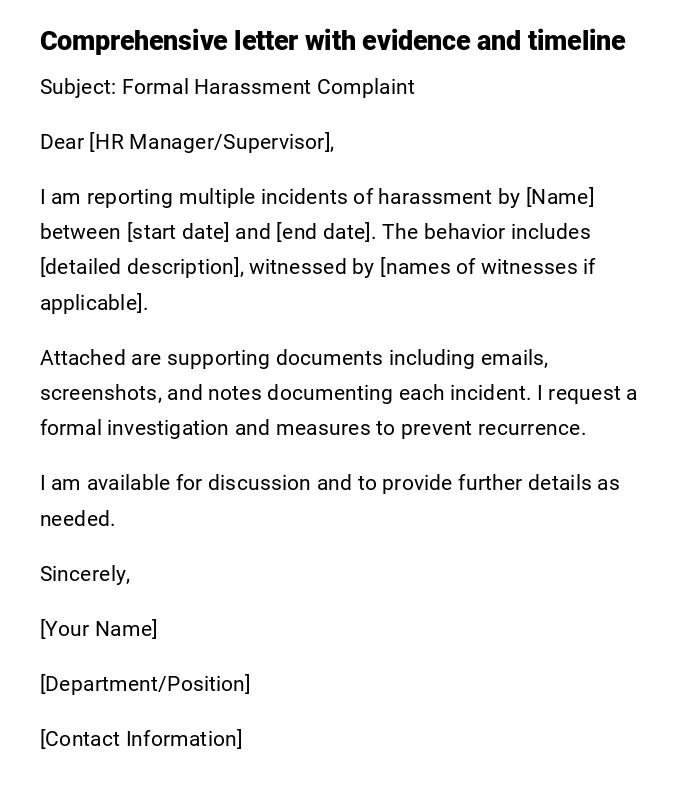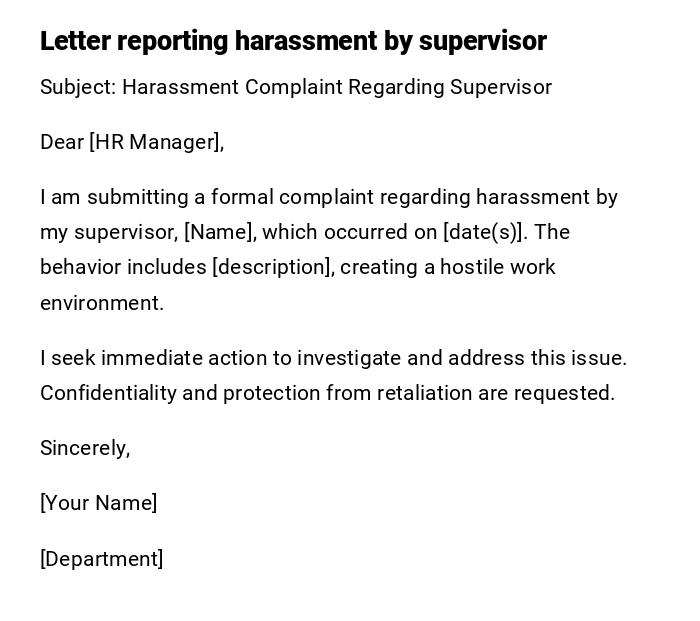Harassment Complaint Letter
Subject: Harassment Complaint
Dear [Recipient's Name],
I am writing this letter to formally lodge a complaint of harassment that I have been experiencing at [Company/Organization Name]. I feel compelled to bring this matter to your attention in order to address the ongoing harassment and create a safe and respectful working environment for all employees.
I would like to outline the incidents of harassment that I have encountered, providing specific details to ensure a comprehensive understanding of the situation. Please note that the following incidents are listed in chronological order:
1. Incident 1: [Describe the incident briefly, including the date, time, location, and individuals involved. Provide a clear and concise account of what happened, specifying any inappropriate comments, gestures, or actions.]
2. Incident 2: [Provide a detailed account of the second incident, including the relevant information as mentioned above.]
3. Incident 3: [Include the necessary details regarding the third incident.]
I believe it is crucial to emphasize that the aforementioned incidents have had a detrimental impact on my well-being and work performance. Harassment of any form is unacceptable and contravenes both the company's policies and legal obligations.
I have attempted to address these concerns informally by communicating directly with the individuals involved. However, the situation has not improved, and the harassment continues to persist. Hence, I have chosen to escalate this matter by submitting this formal complaint.
I kindly request a thorough investigation into these incidents to identify the responsible parties and take appropriate action to rectify the situation. It is of utmost importance that immediate measures be taken to ensure my safety and well-being within the workplace.
I also want to highlight that, as an employee, I have the right to be protected from retaliation as a result of filing this complaint. I trust that [Company/Organization Name] will handle this matter with the utmost confidentiality and professionalism.
I would appreciate being kept informed of the progress made in addressing this complaint. Please inform me of the actions taken and the expected timeframe for their implementation. Additionally, if there are any further steps or procedures I need to follow, kindly provide me with the necessary instructions.
I have attached any relevant documentation or evidence to support my complaint. Should you require any additional information or clarification, please do not hesitate to contact me via the provided contact details.
I strongly believe that by addressing this issue promptly and effectively, we can foster a harmonious work environment that values respect, equality, and the well-being of all employees.
Thank you for your attention to this matter, and I trust that you will handle it with the seriousness it deserves.
Yours sincerely,
[Your Name]
Formal Harassment Complaint Letter
Subject: Harassment Complaint
Dear [HR Manager/Supervisor Name],
I am writing to formally report an incident of harassment I experienced in the workplace on [date(s)]. The individual involved is [Name of the person], and the behavior included [brief description of harassment].
This situation has caused me distress and impacted my ability to work comfortably. I request a thorough investigation and appropriate action to ensure a safe and respectful environment.
Please acknowledge receipt of this complaint and inform me of the next steps.
Sincerely,
[Your Name]
[Position/Department]
[Contact Information]
Informal Harassment Complaint Email
Subject: Concern Regarding Harassment Incident
Hi [HR Name],
I wanted to bring to your attention an incident that occurred on [date] involving [person's name]. Their actions, including [brief description], have made me uncomfortable.
I would appreciate guidance on how this will be addressed and any support available.
Thank you for listening.
Best,
[Your Name]
[Department/Team]
Detailed Workplace Harassment Letter
Subject: Formal Harassment Complaint
Dear [HR Manager/Supervisor],
I am reporting multiple incidents of harassment by [Name] between [start date] and [end date]. The behavior includes [detailed description], witnessed by [names of witnesses if applicable].
Attached are supporting documents including emails, screenshots, and notes documenting each incident. I request a formal investigation and measures to prevent recurrence.
I am available for discussion and to provide further details as needed.
Sincerely,
[Your Name]
[Department/Position]
[Contact Information]
Harassment Complaint Letter Against a Peer
Subject: Complaint About Peer Harassment
Dear [HR Manager],
I am compelled to report harassment from my coworker, [Name], which occurred on [date(s)]. Specific instances include [description of actions or words], which are affecting my ability to work effectively.
I request that HR investigates this matter promptly and ensures a safe working environment.
Thank you for your prompt attention.
Sincerely,
[Your Name]
[Department]
Harassment Complaint Against a Supervisor
Subject: Harassment Complaint Regarding Supervisor
Dear [HR Manager],
I am submitting a formal complaint regarding harassment by my supervisor, [Name], which occurred on [date(s)]. The behavior includes [description], creating a hostile work environment.
I seek immediate action to investigate and address this issue. Confidentiality and protection from retaliation are requested.
Sincerely,
[Your Name]
[Department]
What / Why: Purpose of a Harassment Complaint Letter
What / Why: Purpose of a Harassment Complaint Letter
A harassment complaint letter is a formal document used to report inappropriate behavior, misconduct, or harassment in professional or institutional settings.
Purpose:
- To officially notify management or HR of unacceptable conduct.
- Document incidents with specific details for record-keeping.
- Initiate investigations and protective measures.
- Ensure a safe and respectful environment for all individuals.
Who Should Send a Harassment Complaint Letter
Who Should Send a Harassment Complaint Letter
- Employees experiencing harassment.
- Students facing harassment in academic settings.
- Individuals witnessing harassment may submit a letter on behalf of the victim.
- Must be someone directly affected or concerned with the incident.
Whom to Address in a Harassment Complaint Letter
Whom to Address in a Harassment Complaint Letter
- Human Resources or HR Manager.
- Immediate supervisors (if not the subject of complaint).
- School administration or academic coordinator.
- Legal or compliance department if necessary.
When to Send a Harassment Complaint Letter
When to Send a Harassment Complaint Letter
- Immediately after an incident occurs or becomes ongoing.
- When informal resolution attempts have failed.
- When witnessing repeated harassment.
- As part of an organization's formal grievance procedure timeline.
How to Write and Send a Harassment Complaint Letter
How to Write and Send a Harassment Complaint Letter
- Start with a clear subject line and greeting.
- Describe the harassment incident(s) with specific dates, times, and details.
- Include the names of witnesses if applicable.
- Attach supporting evidence like emails, screenshots, or notes.
- Maintain a professional, factual, and calm tone.
- Send via official channels: email to HR, internal complaint portals, or printed letter.
Requirements and Prerequisites for Writing the Letter
Requirements and Prerequisites for Writing the Letter
- Collect evidence (emails, messages, or witness statements).
- Document incidents chronologically.
- Familiarize with company or institution harassment policies.
- Ensure confidentiality when drafting the letter.
- Keep personal emotions in check to maintain professionalism.
Formatting Guidelines for Harassment Complaint Letters
Formatting Guidelines for Harassment Complaint Letters
- Length: concise yet detailed, usually 1–2 pages.
- Tone: professional, factual, and serious.
- Structure: Subject, greeting, incident description, impact, request for action, closing.
- Use bullet points or numbered lists for multiple incidents.
- Attach documentation in a clear, organized manner.
After Sending / Follow-up Steps
After Sending / Follow-up Steps
- Confirm receipt of the complaint with HR or administration.
- Request a timeline for investigation or response.
- Keep copies of all correspondence.
- Follow up if no action is taken within reasonable timeframes.
- Maintain confidentiality and avoid discussing the complaint publicly.
Pros and Cons of Filing a Harassment Complaint Letter
Pros and Cons of Filing a Harassment Complaint Letter
Pros:
- Creates an official record of the harassment.
- Initiates corrective action or investigation.
- Provides legal and administrative protection.
Cons:
- Emotional stress during the complaint process.
- Potential backlash or tension with the involved parties.
- Requires careful documentation to avoid disputes.
Common Mistakes to Avoid in Harassment Complaint Letters
Common Mistakes to Avoid in Harassment Complaint Letters
- Using overly emotional or accusatory language.
- Failing to include dates, times, or specific details.
- Omitting evidence or witness information.
- Sending to incorrect recipient or department.
- Ignoring company complaint procedures.
Key Elements and Structure of a Harassment Complaint Letter
Key Elements and Structure of a Harassment Complaint Letter
- Subject line indicating it is a harassment complaint.
- Greeting addressing HR or relevant authority.
- Clear description of incidents with dates and details.
- Names of witnesses if applicable.
- Evidence attachments (emails, screenshots, notes).
- Statement of impact on the sender.
- Request for action and confidentiality.
- Closing with name, department, and contact information.
Tricks and Tips for Effective Harassment Complaint Letters
Tricks and Tips for Effective Harassment Complaint Letters
- Keep the language factual and objective.
- Chronologically document incidents.
- Include only relevant information to avoid confusion.
- Preserve a copy of the letter for personal records.
- Be aware of company policy on confidentiality and retaliation.
Does a Harassment Complaint Letter Require Authorization?
Does a Harassment Complaint Letter Require Authorization?
- Typically, the complainant writes the letter themselves.
- Submission may require acknowledgment from HR or supervisor.
- Certain cases may involve legal or compliance review before formal processing.
- No pre-approval is needed for raising concerns, but adherence to policy is essential.







 Download Word Doc
Download Word Doc
 Download PDF
Download PDF